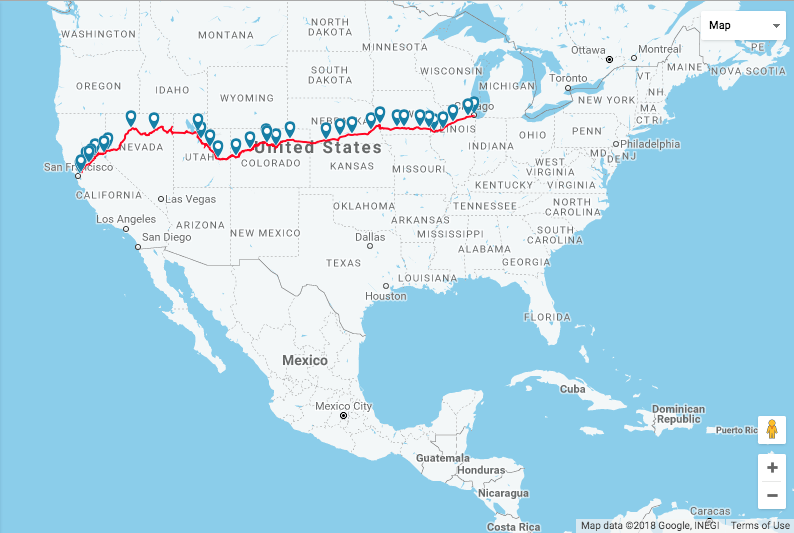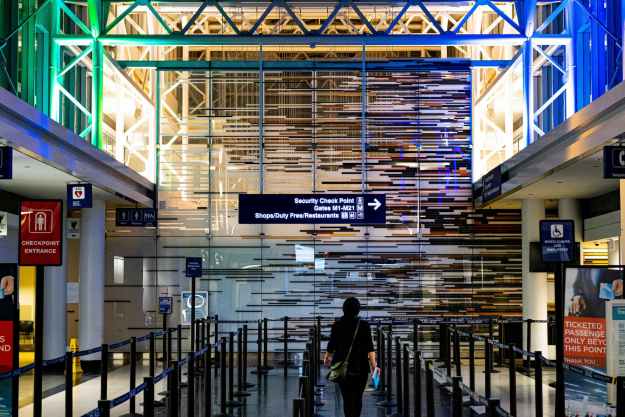One of the great advantages of American rail travel — what makes the length and expense of a long train journey worth it — is the opportunity to see the breathtaking beauty and sweep of the land as you pass through it. An airplane may afford a bird’s-eye views of city grids, patches of rotating crops, or the occasional canyon or mountain, but for appreciating the sheer scale and diversity in climate, topology, and more of the continental United States, nothing compares to a long-distance train. It’s true that on a road trip by automobile a person can stop where they choose and pick their own routes, but with the exception of noted scenic highways, the interstate system can be a soul-sucking tangle of concrete ribbons alleviated by characterless rest stops and an endless cavalcade of the same dozen-odd fast-food restaurants.

I’ve spent days on trains crisscrossing this country, occasionally on rail lines following some of the oldest known overland routes on the continent — in some cases, trails first worn into the earth by ancient herds of buffalo — and I can think of no better way to traverse the plains, mountains, prairies, deserts, forests, and even a few national parks from city to town to village and all points in between. Some lines even have “Trails & Rails” programs where National Parks Service employees give information about the sights. So buy yourself a ticket and park yourself in one of Amtrak’s long-distance glass-domed Sightseer Lounge observation cars for the most scenic views of America you’ve ever seen.
California Zephyr
Departing from Chicago and arriving outside San Francisco in Emeryville, California, via Denver, Colorado, and Salt Lake City, Utah, (or reverse, if heading east,) the Zephyr is famous for being Amtrak’s most scenic train. It’s more than a two-day trip (51 hours without delay,) and the first day (heading west) takes you across Illinois, Iowa, and Nebraska. If you’re picturing lots of corn, you’re right. That first day is a dive right into the deep end of just how much corn is grown in this country, occasionally punctuated by ruminating cattle and horses.

But if corn to the horizon isn’t your notion of the ideal vista, don’t fret. The next morning, after an hour or so at Denver’s gorgeous Union Station — complete with a luxury hotel, dining, and shopping, as well as light rail and bus connections throughout the city and to local ski spots if you decide to stay — the Zephyr heads off up into the beautiful Rocky Mountains.
You ascend into the mountains along a series of gloriously-engineered tunnels, embankments, and cuttings carved out of the Earth that take the train ever higher, curving through valleys and rounding peaks to reveal the vast sweeps of plain you’ve just left behind. The vegetation changes as you rise, as does the fauna; you’ll definitely see deer, and sightings of mountain lions and bears aren’t unheard of either. There’s a brief stop at the beautiful historic Glenwood Springs, a hot springs resort town favored by Teddy Roosevelt, where you can stretch your legs and get a lungful of mountain air.
Texas Eagle

I’ve heard the Texas Eagle described as “the pride of the fleet” by Amtrak announcers. I’m unsure whether this is merely an example of typical Texan boasting or a genuine claim, but either way, this train deserves mention as one of the prettiest rides in America. The Eagle flies daily from Chicago to San Antonio, with three trains a week making a hook turn to continue on to Los Angeles. The first leg of the trip down through Missouri and Arkansas is only really spectacular if you manage to get a near-full moon shining at night when you’re going through the swamps — it’s a picture of haunting serenity. The next day, when the sun is high, you should be able to revel in that incredible unmatched capacity for distance that the Texas landscape affords. One particular highlight is crossing the Brazos river, its arms stretching out on either side seemingly to infinity. True to its name, I have actually seen eagles soaring overhead while riding this train.
Heartland Flyer

Connecting to the Texas Eagle route at Fort Worth is the little-known and often-overlooked Heartland Flier. This line, subsidized by the State of Oklahoma, provides service to Oklahoma City, and although it isn’t an exceptionally long trip, it boasts some lovely views, especially if you catch some of that inimitable tornado-alley electric weather; I once saw a discrete thundercloud waltz from one end of the horizon to the other, passing over our observation car hurling jagged lighting and sleet the whole time while the rest of the sky stayed clear blue and calm around it. The old Southwest Railroad station in Oklahoma City is also one of the prettiest small stations I’ve ever seen, decorated in a Native American-chic Art Deco style.
Sunset Limited

The Sunset Limited travels between Los Angeles and New Orleans, skirting the Mexican Border, with major stops in Phoenix, Tucson, El Paso, San Antonio, and Houston. As the name implies, one of the great attractions on this trip is the sun. Whether you’re riding towards or away from it as it sets or rises, the light you’ll see on this trip — especially during the portions in the Arizona, New Mexico, and West Texas deserts — gives the dusty land the purple-and-orange cast for which the West is so famous. The large desert clouds in their dawn and twilight hues soaring over the rocky landscapes only add to the extraterrestrial feeling of this ride.
Crescent

The Crescent, which swings between New York and New Orleans via Atlanta, isn’t an especially picturesque train (it doesn’t even have an observation car) except for one very special part: on the ride in or out of New Orleans, the train goes across big and beautiful Lake Pontchartrain. This all-too-brief segment of the journey approaches the truly sublime. Picture the Crescent, speeding across a narrow causeway, with water as far as the eye can see on either side and waterfowl flocking overhead. You feel like a stone skipping across the ocean. If you board the train headed north, this indescribable scene is made even more beautiful by taking place early in the morning with the sun, low in the sky, still nearly kissing the brim of the lake.
Editors' Recommendations
- The 5 states with the most wineries (besides California)
- The View of an American Road Trip from the Back of a Motorcycle
- Newfoundland Road Trip Itinerary: Where to Visit, Eat, and Stay on the Canadian Island


